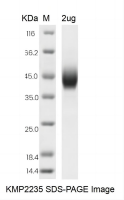Service Line:+86-022-82164980
Address:FL-4, Building A5, International Enterprise Community, Tianjin, China
Email:[email protected]
| Catalog Number | KMP2235 |
|---|---|
| Product Name | Human CD24 Protein, mFc Tag |
| Product Description | The Human CD24 Protein(KMP2235) is produced in HEK293 Cells and the target gene encoding Ser27-Gly59 is expressed with a mFc tag at the C-terminus. |
| Molecular Weight | 3.13 kDa |
| Alias | Signal transducer CD24, CD24 |
| Species | Human |
| Host | HEK293 Cells |
| Size | 50ug, 100ug, 200ug |
| Purification | Affinity purification |
| Purity | >95% as determined by SDS-PAGE |
| Endotoxin | <1.0 EU/ug determined by the LAL method |
| Buffer | PBS, pH7.4 |
| Uniprot | P25063 |
| SDS-PAGE |  |
| Function | May have a pivotal role in cell differentiation of different cell types. Signaling could be triggered by the binding of a lectin-like ligand to the CD24 carbohydrates, and transduced by the release of second messengers derived from the GPI-anchor. Modulates B-cell activation responses. Promotes AG-dependent proliferation of B-cells, and prevents their terminal differentiation into antibody-forming cells (PubMed:11313396). In association with SIGLEC10 may be involved in the selective suppression of the immune response to danger-associated molecular patterns (DAMPs) such as HMGB1, HSP70 and HSP90. Plays a role in the control of autoimmunity (By similarity). |
| Background | Signal Transducer CD24 is a heavily and variably glycosylated GPI-linked sialoprotein. Human CD24 is expressed on B lineage cells and granulocytes, on epithelial, neuronal, and muscle cells, and on a range of tumor cells. CD24 expression is regulated during lineage development and with the activation of various cell types. Antibody crosslinking of CD24 enhances the induction of apoptosis in B and T lymphocytes which contributes to negative selection and the induction of immune tolerance. CD24 on antigen presenting cells cooperates with B7 molecules in the costimulation of T cells. CD24 associates in cis with Siglec10 and with the danger-associated molecules HMGB1, HSP70, or HSP90 which are released from necrotic or damaged cells. Formation of these ternary complexes fills a protective role: the resulting Siglec10 signaling inhibits inflammatory responses that are otherwise induced by extracellular DAMPs. |
| Storage | Aliquot and store at -20℃ to -80℃. Avoid repeated freezing and thawing cycles. |
| Note | This product is for research use only. |
| References | J. Immunol. 166:5567-5577 (2001) |